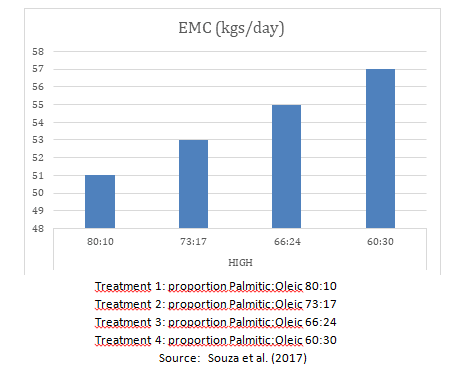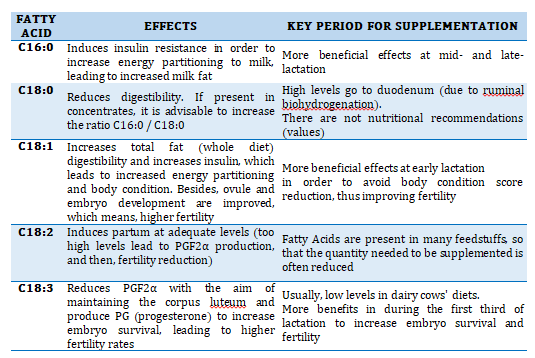C16:0/C18:1 for Dairy Cows Already Formulating on a Fatty Acids Basis?
Published: December 6, 2018
By: Alfredo J. Escribano / DVM, PhD, NUTRION Internacional, www.nutrion.es.
INTRODUCTION: THE FATTY ACIDS FORMULATION APPROACH
The use of fats or oils in dairy cow rations is a common strategy to increase the energy density of the ration and maintain milk production (Rabiee et al., 2012). However, fats do not only provide with energy, but also interesting fatty acids needed for different physiological processes of great impact in dairy cows.
Similarly to the evolution from proteins to amino acids formulation in the dairy sector, now it is time for the change the formulation approach from fats to that of fatty acids.
In order to formulate rations based on fatty acids it is necessary to know different key parameters of each fatty acid, both individually and in combination.
#1 KEY PARAMETER: DIGESTIBILITY
Digestibility is a key factor in the nutritional evaluation of any source of fat. In this sense, C18:0 presence reduces overall fats’ digestibility (Boerman et al. 2015), due to its low solubility compared with other fatty acids and, especially, with respect to palmitic acid. Palmitic acid, on the other hand, has a constant digestibility, although its flow to the duodenum is increased (Rico et al., 2017) due to the low presence of sixteen carbons unsaturated fatty acids. As a consequence, an adequate C16:0 / C18:0 ratio is interesting to maintain good digestibility levels in fat supplements (Drackey, 2000).
Moreover, unsaturated fatty acids (both mono- and polyunsaturated ones), such as oleic acid (C18:1) have a high duodenal digestibility so that they increase the digestibility of total fat present in the ration.
Figure 1. Digestibility of different C16:0 / C18:1 combinations
Treatment 1: | Control: no supplemented fat |
Treatment 2: | High C16:0 Supplement (80% approx.) |
Treatment 3: | C16:0 & C18:0 blend - fat supplement (40% of each product approx.) |
Treatment 4: | C16:0 (45%) & C18:1 (35%, in form of Ca-salts) blend, fat supplement |
Source: Souza et al. (2017) |
#2 KEY PARAMETER: EFFECTS OF THE DIFFERENT FATTY ACIDS
The effects of fatty acids may also be due to the effects of lipid intermediates, such as sphingolipid ceramides. Ceramides reduceinsulin sensitivity (Rico et al., 2015), improve the mobilization of non-esterified fatty acids (NEFA) in adipose tissue and increase milk production (Rico et al., 2016; Davis et al., 2017). Palmitic acid is the substrate for the de novo synthesis of ceramide (McFadden, 2017), which indicates a link between the increase in the supplementation of this fatty acid and the mechanisms to partition energy towards milk production.
Why adding just C16:0 is not so good:
Despite palmitic acid supplements help to increase milk fat production, potential negative consequences on cows’ metabolism must be taken into account. Early-lactation cows have a genetic predisposition to drive energy to milk production, which is carried out at the expense of body condition loss. Palmitic acid can exacerbate this issue as it has a strong influence on insulin resistance. Hence, adding more palmitic acid to fresh cows may aggravate this natural partitioning of nutrients, then mobilizing body reserves in excess, and increasing the risk of metabolic diseases incidence along with reproductive problems (due to loss of body condition and increase of NEFA and BHB). Also, a series problems have been observed after the use of palmitic acid supplements: changes in butter and cheese quality (due to the increase in their melting point), increase of the saturated/unsaturated ratio in dairy products (less healthy). On the positive side, it must be said that.
In contrast, the stimulatory effects of insulin by C18:1 indicate that this fatty acid is particularly desirable at the onset of lactation to increase the distribution or partitioning of energy to body reserves, thus reducing body condition loss. Also, as already mentioned, fats’ digestibility will be increased. This also has consequences on reproduction: additional energy available for the cows and improvements in the quality of the follicle and better early embryonic development, which implies a significant improvement in fertility (Aardema et al., 2011). More effects can be observed in table 1.
Figure 2. Effect of different C16:0 / C18:1 combinations on milk production

In this study, it was found that the proportion 60% of C16:0 and 30% of C18:1 is the best option.
Table 1. Summary of main Fatty Acids’ Effects and Supplementation Periods

CONCLUSIONS
Once the practitioner knows the overall effects of fatty acids (effects on dry matter intake, rumen metabolism, digestibility, energy partitioning, milk components synthesis, body condition, immune system and reproductive performance) it is possible to design a fatty acids feeding strategy. On this regard, it can be stated that the C16:0 / C18:1 balance is important.
The proportion 60/30 (Palmitic/Oleic acid) allows reconciling milk yield with milk fat synthesis and body condition, by means of a higher digestibility, better metabolic consequences, body condition and reproduction. On the market side, we will keep the quality of dairy products and their contribution to human health (saturated/unsaturated ratio).
This is a version of the following article: A. J. Escribano. 2018. Formulating rations on a fatty acids basis. Stock Farm, September, pp. 34-35. The article was submitted by the author for its reproduction.
Related topics:
Authors:
Orffa Excentials
Recommend
Comment
Share

Would you like to discuss another topic? Create a new post to engage with experts in the community.






